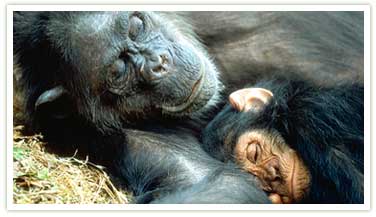Continuing Jane Goodall’s Groundbreaking Research on Wild Chimpanzees
 Mother and infant chimpanzees sleeping. Gombe National Park, Tanzania.
Mother and infant chimpanzees sleeping. Gombe National Park, Tanzania.
© Bill Wallauer
In July 1960, Jane Goodall arrived for the first time at the Gombe Stream reserve in what was then Tanganyika. She had been chosen by paleontologist and anthropologist Louis Leakey to study the behavior of the chimpanzees living there. Her observations at Gombe would revolutionize primatological research.
Her first extraordinary observation came just a few months after her arrival at Gombe, when she saw a chimpanzee making and using a simple tool:

|
“I can never forget that day,” she wrote in her children’s book, My Life with the Chimpanzees. “Peering through some vegetation, I saw a dark shape hunched over a termite mound. I realized it was the male whom I had named David Greybeard. I watched as he picked a piece of grass and pushed it carefully into a tunnel in the mound. He withdrew it covered with termites clinging on with their mandibles, and he picked them off. Crunch, crunch. Delicious! It was even more thrilling to watch him as he broke off a leafy twig and stripped it of leaves to use it for fishing out termites.”
Until then, it was thought that humans—and only humans—used and made tools. The very definition of humans at that time was “Man the Tool Maker.” Louis Leakey, upon hearing of the discovery, is reported to have said, “Now we must redefine man, redefine tool—or accept chimpanzees as human!”
[1] [2]